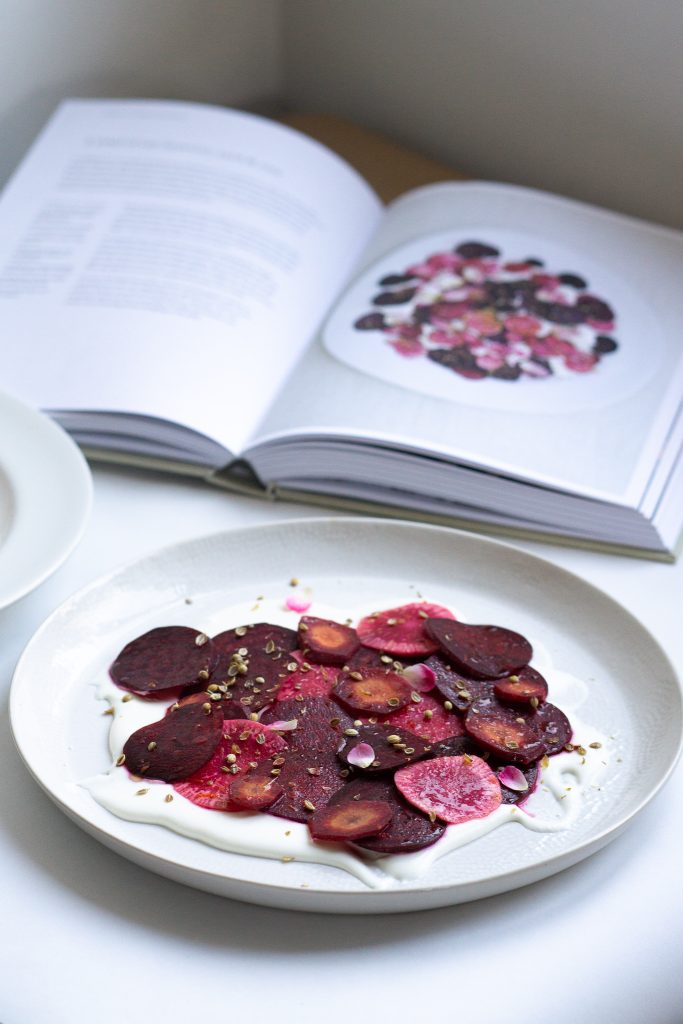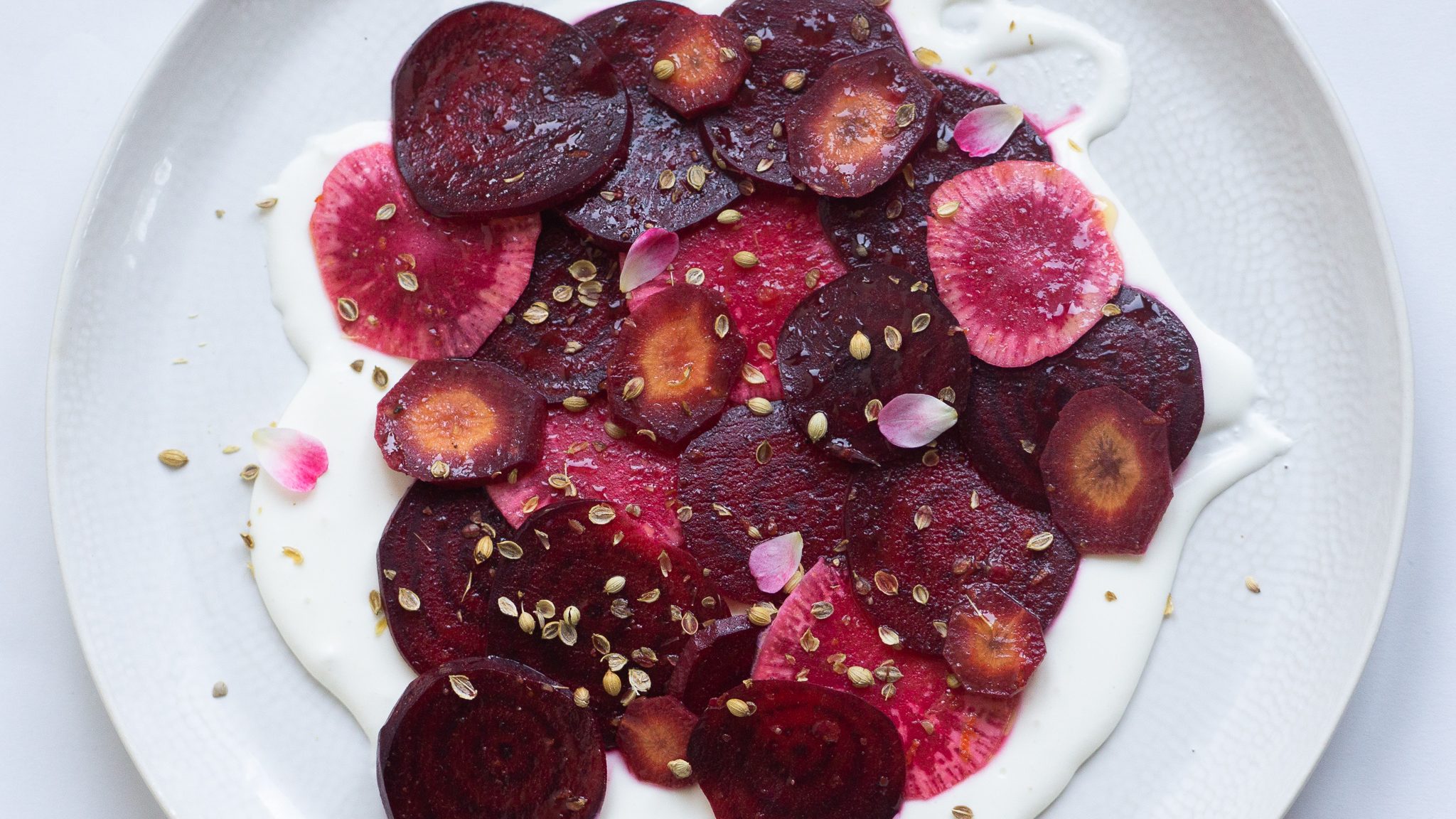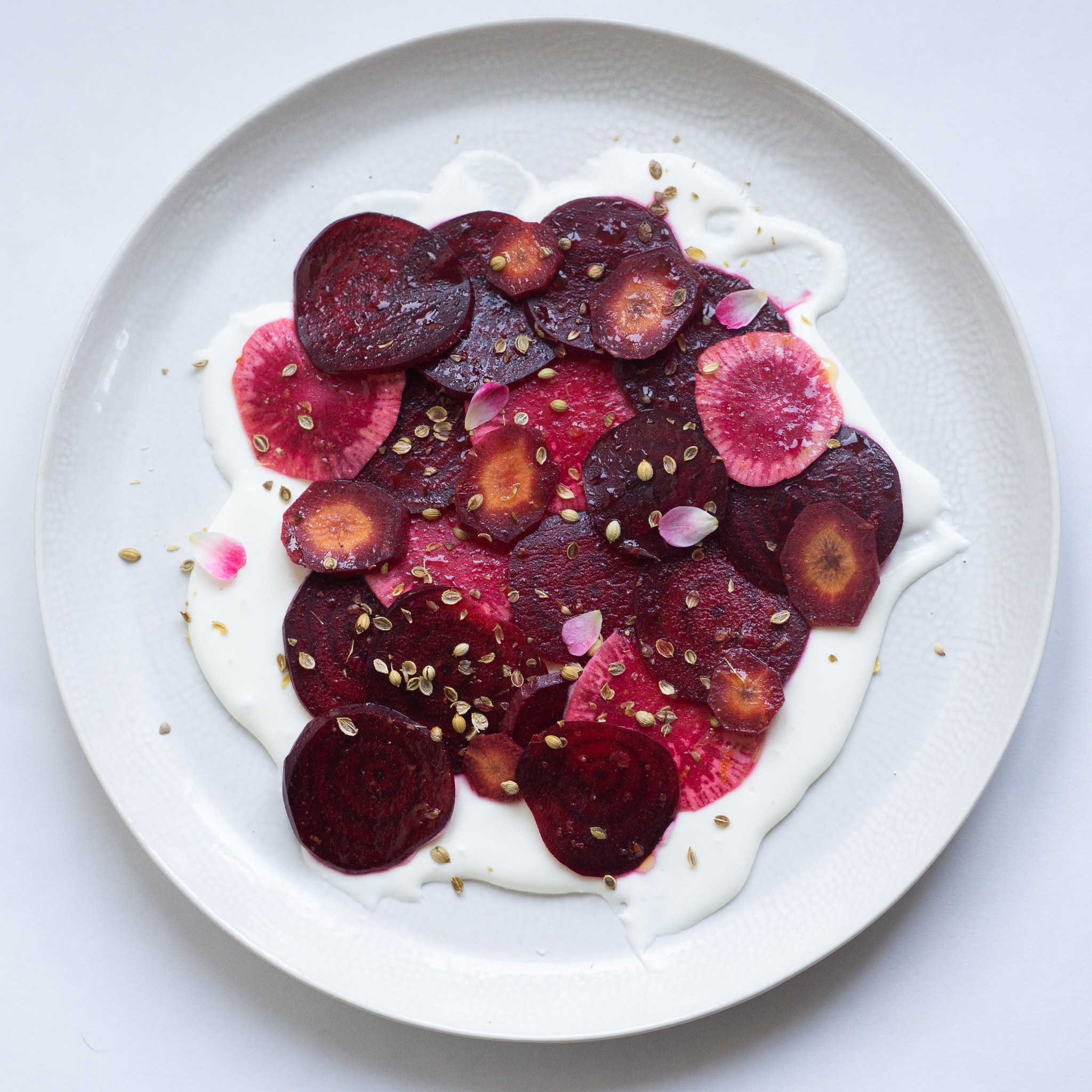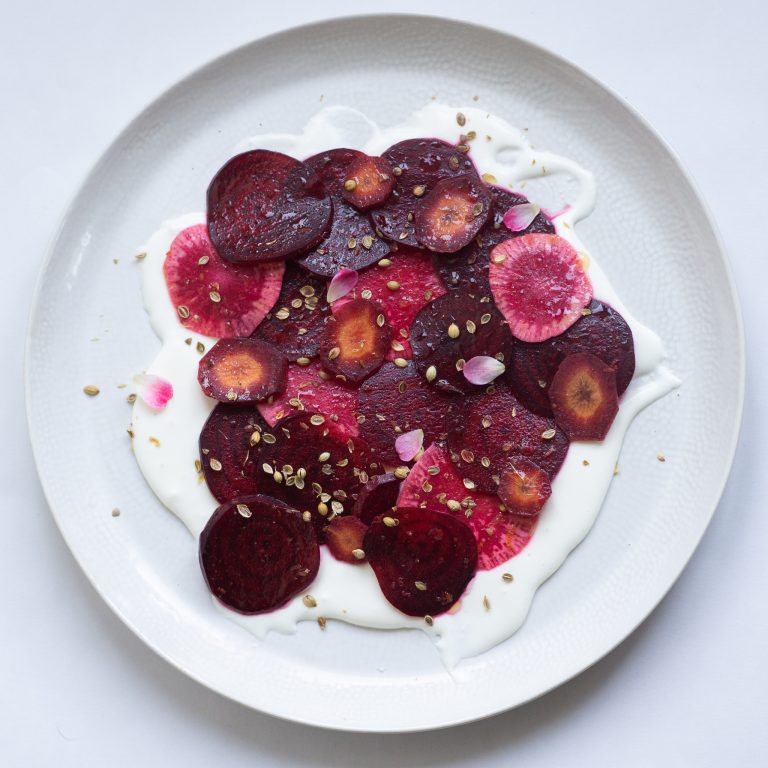The inspiration for this recipe came from a wonderful cookbook called Gather by Gill Meler. At the time I tried it, we were on lockdown and I was fermenting A LOT of my own food and drinks including milk kefir, which, just like a good sourdough starter is forever giving, and I was genuinely running out of ways to use it up! So this recipe was a welcome and unexpected surprise.
This dish is a beautifully sweet, tart and light salad that works on many occasions, a simple plate on a summers night, an unexpected side at a BBQ and a fresh addition to a Mediterranean feast. Personally I love beetroot, but I do find it hard to figure out ways to use and celebrate it in my cooking. This is one of those welcome beetroot first recipes I love to whip out when the season hits.
Yoghurt, kefir and other fermented milk products, what’s the difference?
Yogurt, kefir, and a large diversity of other fermented milk products have been consumed for centuries. From the Shepard on the hill who realised fermented goats milk was helping him stay well through the winter, to the cheeses of the Royal banquet halls of France – fermenting and preserving dairy is a long heralded tradition that come along with many health benefits, not least to mention, enjoyment!
This recipe calls on the use of kefir, but you could just as easily be yoghurt or even another kind of cultured cream, If you don’t know what the difference is though, here’s little insider info:
- Yogurt: Yogurt is made by fermenting milk with two now widely accepted strains of bacteria, typically Lactobacillus bulgaricus and Streptococcus thermophilus. It’s usually done in a temperature controlled and sterilised environment. Essentially it’s a way to stop milk going bad as the bacteria convert lactose, the natural sugar in milk, into lactic acid, which gives yogurt its tangy taste, thick texture and longevity.
- Kefir: Kefir is made by fermenting milk with kefir grains, which are a combination of wild bacteria and yeasts living on some kind of floating structure made from yet more bacteria and yeast. The strains in these grains can vary wildly (literally) depending on the kitchen and climate its being fermented in, though it does have a general foundation of lactobacillius bacteria. This fermentation process produces a thinner, sourer, and sometimes slightly effervescent beverage because the yeasts have a tendency to carbonate. This diversity of micro-organisms, however, is why its known for its probiotic properties and is believed to have additional health benefits beyond those of yogurt.
- Buttermilk: Buttermilk is traditionally made from the liquid left behind after churning butter. Left to ferment it produces a tangy flavour and a slightly thicker consistency than regular milk. Nowadays, buttermilk is often made by fermenting low-fat or skim milk with lactic acid bacteria ( a similar process to yoghurt making) and is commonly used in baking to add moisture and a subtle tanginess to recipes.
- Sour Cream: Sour cream is simply cream fermented with lactic acid bacteria, and its application in baking shouldn’t be forgotten – it makes a great substitute for yoghurt if you don’t have any on hand and Its thick and creamy texture is perfect for thickening sauces and adding a little extra omph to your caramel.
- Labneh: Labneh, also known as strained yogurt or yogurt cheese, is made by straining yogurt to remove the whey. The result is a thicker, creamier yogurt with a more concentrated flavor. Labneh is often used as a spread or dip and can be flavored with herbs, spices, or olive oil. It is a popular Middle Eastern and Mediterranean food.
Fermented milk products provide a good source of nutrients, probiotics, and have a tried and tested place as part of a healthy diet. It’s important to remember though, that when you cook these products, you do loose the probiotic element due to the heating process.
Anonymous
Life is a vibrant tapestry, and each beetroot slice adds its own brilliant hue to the salad of existence.
Also Read: Beetroot, black pudding and walnut salad (tba)

The fun of choosing beetroot varieties:
When I think beetroot, I think ‘what fun” – I remember the first time I cut into an heirloom beet and witnessed the beautiful purple and pink hues becoming more apparent with every slice. I thought to myself, “I think this is genuinely one of the prettiest vegetables around” and then I also thought to myself “But what do you do with it?” – Since then, I’ve developed a love affair with this vegetable and i’ve found a good handful of recipes that truly celebrate it in all its Earthy glory, but I have to say none that truly celebrate its beauty the way that this recipe does.
Believe it or not, beetroots comes in a variety of colours. These more festive varieties have a slightly unique taste in comparison to the regular crimson beetroot but they still give the same depth of flavour as their originator. If you’re planning on making this recipe you’ll definitely want to be on the lookout for them!
Rainbows and beetroots…
- Golden Beetroot: Also known as yellow beets, golden beets have a bright yellow or golden flesh. They offer a sweeter and milder flavor compared to red beets.
- Chioggia Beetroot: Named after the Italian town of Chioggia, these beets have a distinctive pink and white concentric ring pattern when sliced. The flesh is sweet and tender.
- Candy Stripe Beetroot: This variety, also known as Bull’s Eye Beet, features a beautiful pink and white striped pattern on the inside. It adds a visually striking element to salads and dishes.
- White Beetroot: White beets have pale cream or white skin and flesh. They have a milder and slightly sweeter flavor compared to red beets.
- Cylindra Beetroot: Cylindra beets are elongated and cylindrical in shape, with a dark purplish-red color. They have a sweet flavor and are often used for pickling or slicing into uniform rounds.
These colourful beetroot varieties not only add a vibrant visual appeal to any dish they interact with, they also contribute a diversity of flavours and textures. Whether you managed to hunt them down at the local farmers market or grew them yourself, your likely to find yourself falling in love with these new ingredients.
How to choose your beetroot:
Since this is one of those dishes that’s so simple, and without any cooking involved, it’s imperative to choose high quality ingredients because there’s no where to hide otherwise. Here’s some tips for getting the best and most flavourful beetroot for the recipe.

When choosing beetroot, here are some tips to help you select the best ones:
- Size and Weight: Look for beetroot that is firm and heavy for its size. Avoid ones that feel soft, lightweight, or have visible blemishes, as these may indicate spoilage.
- Smooth Skin: The skin of the beetroot should be smooth and free from cuts, cracks, or bruises. Avoid any beets with rough or damaged skin.
- Vibrant Color: Choose beetroots with a deep, vibrant color. This can vary depending on the variety, but generally, a rich, dark red or purple color indicates freshness. However, some varieties, such as golden or striped beets, will have a different color.
- Fresh Greens: If the beetroot has its greens (leaves) still attached, they should be fresh, crisp, and bright green. The greens can give you an indication of the beetroot’s freshness. Avoid beets with wilted or yellowing greens, as this may indicate the root has been stored for a long time.
- Medium to Small Size: Smaller or medium-sized beets are often more tender and have a sweeter flavor compared to larger ones. However, the size can also depend on your specific recipe and preferences.
- Organic Options: If possible, consider choosing organic beetroot to minimize exposure to pesticides and chemicals. Organic beets are grown without synthetic fertilizers and pesticides, which can be a healthier choice.
Remember to give the beetroot a gentle squeeze to ensure it feels firm and has no soft spots. If you’re uncertain about the freshness or quality of a beetroot, it’s best to choose another one. Freshly harvested beets will generally have the best flavor and texture.
A note on ingredients:
I slightly increase the amount of each ingredient to produce extra frosting. If you prefer a thinner layer of frosting, use the chocolate buttercream recipe.
Beetroot: As above
Labneh: Its rare that I come across this in the shops, so I usually make my own. Simply line a strainer with a piece of cheesecloth and pour at least 500ml of kefir or yoghurt into it and leave it to drain overnight (in the fridge) and viola, you’ll have homemade labneh!
Feta: For this recipe it’s really important to use proper goats milk feta, you just don’t get the depth of flavour without it.
Oranges: I’ve not tried with any other type than the regular but I’d imagine blood orange would contribute to the overall complexity of this dish. Regular oranges do just fine though!
Coriander seeds: Please make sure to toast them, it’s this process that helps to contribute to the overall mediterranian and savoury feel to the dish.

Beetroot, Whipped Feta, Kefir & Rose Salad
Equipment
- 1 Mandolin
- 1 electric or stand beater
Ingredients
- 6 whole beetroots (preferably heirloom and interesting colours and the smaller the better) (slided thin with a mandolin )
- 1/2 cup kefir or yoghurt labneh ((must be labneh or mix will be too thin))
- 1/2 cup goats feta
- 1 tsp rose water
- 1 juice and zest of 1 orange
- 1 – 2 tsp coriander seeds (toasted and crushed)
- 1/2 lemon juice of
- 2 tbsp olive oil
- 1 tsp rose petals ((optional – for garnish) )
Instructions
- Using a mandolin, shave the beetroot into really thin pieces.
- Mix the orange, olive oil and rose water with a twist of salt and pepper, pour half of the mixture onto the beetroot slices, mix through and leave to set for at least 20 minutes.
- Place the feta and labneh in a large bowl and whip with a hand beater until fluffy and solid.
- Spoon the whipped feta onto a plate and layer with the slices of beetroot.
- Spoon on the rest of the dressing and top with coriander and rose petals. Serve immediately or fresh from the fridge on a hot day.
Did you make this recipe?
Lovely. Now let me know how you liked it. Tag me @thetastyspoonful on Instagram or send us a message on Facebook @ The Tasty Spoonful
While I have you here, may I suggest you try these next:
Until next time. Keep following, liking, sharing, commenting and cooking, and may your every spoonful be tastier than the last!




